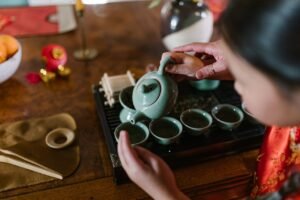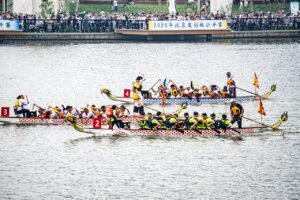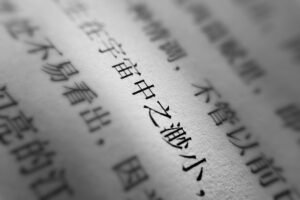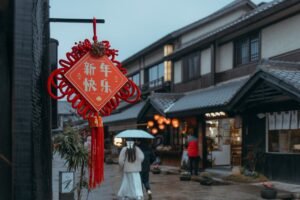The dragon (龙, lóng) is one of the most iconic and revered symbols in Chinese culture. Representing power, strength, and good fortune, dragons have played a significant role in Chinese mythology, art, literature, and everyday life for thousands of years. This article explores the cultural significance of dragons, key mythical stories, and introduces important Mandarin terms to deepen our understanding of this fascinating aspect of Chinese heritage.
Table of Contents
ToggleThe Mythical Origins of Dragons
Dragons in Chinese mythology are vastly different from their Western counterparts. Instead of being fearsome, fire-breathing creatures, Chinese dragons are benevolent and auspicious, often associated with water and the heavens.
The Creation Myth
One of the earliest myths involving dragons is linked to the creation of the world. According to legend, the dragon was one of the first creatures to emerge from chaos. Nuwa (女娲, Nǚwā), the goddess who created humanity, is often depicted with the body of a serpent or dragon, symbolizing her connection to this primordial power.
The Nine Sons of the Dragon
The dragon is also said to have nine sons (龙生九子, lóng shēng jiǔ zǐ), each with unique characteristics and roles. These sons are often depicted in Chinese art and architecture, each embodying different aspects of their father’s power and personality.
- Bixi (赑屃, bìxì) – Often depicted as a turtle, Bixi carries heavy stone tablets and represents strength.
- Chiwen (螭吻, chīwěn) – Known for his love of literature and often seen on roof ridges to protect against fire.
- Pulao (蒲牢, púláo) – Fond of roaring, he is commonly seen on bells as a symbol of sound.
- Bi’an (狴犴, bì’àn) – Symbolizing justice, often seen on prison gates.
- Taotie (饕餮, tāotiè) – Represents gluttony and is often depicted on ancient bronze vessels.
- Baxia (霸下, bàxià) – Associated with water and floods, often seen in water-related structures.
- Yazi (睚眦, yázì) – A symbol of valor, often seen on weapons.
- Suanni (狻猊, suānní) – Resembles a lion and is associated with fire, often seen on incense burners.
- Jiaotu (椒图, jiāotú) – Represents protection and is seen on door knockers to guard against evil.
The Dragon King
The Dragon King (龙王, Lóng Wáng) is a significant figure in Chinese mythology, ruling over the seas and rivers. There are four Dragon Kings, each governing one of the four seas (四海, Sìhǎi) of China: the East Sea (东海, Dōnghǎi), South Sea (南海, Nánhǎi), West Sea (西海, Xīhǎi), and North Sea (北海, Běihǎi). The Dragon Kings are revered for their control over water and weather, and are often invoked during times of drought or flood.
The Cultural Significance of Dragons
Dragons have a profound impact on various aspects of Chinese culture, from festivals and celebrations to art and architecture.
Festivals and Celebrations
The most prominent festival featuring dragons is the Dragon Boat Festival (端午节, Duānwǔ Jié), held on the fifth day of the fifth lunar month. This festival commemorates the poet Qu Yuan (屈原, Qū Yuán) and features dragon boat races, where teams paddle in long, dragon-shaped boats. The festival is not only a time of sporting competition but also a way to honor cultural heritage and community spirit.
Another significant celebration is the Chinese New Year (春节, Chūnjié), where dragon dances (舞龙, wǔ lóng) are performed to scare away evil spirits and bring good luck. These dances involve long, flexible dragon figures manipulated by a team of dancers, accompanied by the sound of drums and cymbals. The dragon dance is a vibrant display of color and movement, symbolizing prosperity and happiness for the coming year.
Art and Architecture
Dragons are a common motif in Chinese art and architecture. They adorn everything from imperial palaces and temples to everyday objects. The Forbidden City (紫禁城, Zǐjìnchéng) in Beijing, for instance, features numerous dragon decorations symbolizing the emperor’s authority and divine right to rule. The dragon is often depicted alongside the phoenix (凤凰, fènghuáng), representing the harmonious balance between yin and yang.
In traditional Chinese painting (国画, guóhuà), dragons are often depicted soaring among the clouds or swimming in the ocean, embodying the harmonious balance between heaven and earth. These images are not merely decorative but also convey deeper philosophical meanings about the universe and humanity’s place within it. Dragon sculptures and carvings are also prevalent, often found on bridges, roofs, and walls, serving both decorative and protective functions. For example, dragon pillars (龙柱, lóng zhù) are common in temples, symbolizing support and strength.
Literature and Folklore
Chinese literature and folklore are rich with dragon tales. One of the most famous stories is that of the Dragon Pearl (龙珠, lóng zhū), a magical gem that grants its possessor great power and fortune. In the tale, dragons are depicted as wise and benevolent beings, capable of great magic and influence. Dragons in literature often serve as guardians of treasure, protectors of the innocent, and symbols of imperial power.
In the classic novel “Journey to the West” (西游记, Xīyóu Jì), the dragon prince transforms into a horse to aid the monk Xuanzang (玄奘, Xuánzàng) on his pilgrimage. This story illustrates the dragon’s role as a helper and protector, reinforcing their benevolent image in Chinese culture. Dragons also appear in many other classical works, such as “The Water Margin” (水浒传, Shuǐhǔ Zhuàn) and “Romance of the Three Kingdoms” (三国演义, Sānguó Yǎnyì), where they symbolize various virtues and powers.
Dragons in Modern China
While ancient myths and legends continue to influence modern Chinese culture, dragons have also found new expressions in contemporary society.
Symbol of National Identity
The dragon is a powerful symbol of Chinese national identity and pride. It represents the country’s strength, resilience, and cultural heritage. The phrase “Descendants of the Dragon” (龙的传人, lóng de chuánrén) is a popular way for Chinese people to express their cultural identity and unity. This phrase is often used in speeches, literature, and songs to evoke a sense of shared history and destiny among Chinese people worldwide.
Commercial and Popular Culture
In modern China, dragons are widely used in branding and advertising to convey qualities like power, excellence, and good fortune. From corporate logos to mascots for major events, the dragon’s image remains a potent symbol in the commercial sphere. For instance, the Chinese sportswear brand Li-Ning (李宁, Lǐ Níng) uses the dragon motif to symbolize strength and agility.
The dragon is also prevalent in popular culture, appearing in movies, television shows, and video games. These modern representations often blend traditional elements with contemporary aesthetics, keeping the dragon relevant for new generations. In films like “Crouching Tiger, Hidden Dragon” (卧虎藏龙, Wòhǔ Cánglóng) and animated series such as “Dragon Ball” (龙珠, Lóngzhū), dragons continue to captivate audiences with their mystical allure.
Environmental and Cultural Conservation
Efforts are being made to preserve the cultural heritage associated with dragons. Museums and cultural institutions organize exhibitions and educational programs to teach the history and significance of dragons in Chinese culture. Additionally, traditional dragon crafts and performances are supported to ensure their continuity. For example, the art of dragon boat crafting and the techniques of dragon dance choreography are taught to younger generations, preserving these cultural practices.
Dragons in Modern Celebrations
Dragons continue to play a significant role in modern celebrations. During the 2008 Beijing Olympics, the dragon was a prominent symbol, featured in the opening ceremony and various cultural displays. The mascot, Jingjing (晶晶, Jīngjīng), was one of the Fuwa (福娃, Fúwá) and represented the panda, another symbol closely associated with Chinese culture, but the imagery and presence of dragons were pervasive throughout the games, symbolizing China’s rich cultural heritage and its aspiration to soar to new heights on the global stage.
Mandarin Terms Related to Dragons
To further understand the cultural significance of dragons in China, here are some important Mandarin terms:
- 龙 (lóng) – Dragon
- 女娲 (Nǚwā) – Nuwa
- 龙生九子 (lóng shēng jiǔ zǐ) – Nine sons of the dragon
- 赑屃 (bìxì) – Bixi
- 螭吻 (chīwěn) – Chiwen
- 蒲牢 (púláo) – Pulao
- 狴犴 (bì’àn) – Bi’an
- 饕餮 (tāotiè) – Taotie
- 霸下 (bàxià) – Baxia
- 睚眦 (yázì) – Yazi
- 狻猊 (suānní) – Suanni
- 椒图 (jiāotú) – Jiaotu
- 龙王 (Lóng Wáng) – Dragon King
- 四海 (Sìhǎi) – Four Seas
- 东海 (Dōnghǎi) – East Sea
- 南海 (Nánhǎi) – South Sea
- 西海 (Xīhǎi) – West Sea
- 北海 (Běihǎi) – North Sea
- 端午节 (Duānwǔ Jié) – Dragon Boat Festival
- 屈原 (Qū Yuán) – Qu Yuan
- 春节 (Chūnjié) – Chinese New Year
- 舞龙 (wǔ lóng) – Dragon dance
- 紫禁城 (Zǐjìnchéng) – Forbidden City
- 凤凰 (fènghuáng) – Phoenix
- 国画 (guóhuà) – Traditional Chinese painting
- 龙珠 (lóng zhū) – Dragon Pearl
- 西游记 (Xīyóu Jì) – Journey to the West
- 玄奘 (Xuánzàng) – Xuanzang
- 水浒传 (Shuǐhǔ Zhuàn) – The Water Margin
- 三国演义 (Sānguó Yǎnyì) – Romance of the Three Kingdoms
- 龙的传人 (lóng de chuánrén) – Descendants of the Dragon
- 李宁 (Lǐ Níng) – Li-Ning (brand)
- 卧虎藏龙 (Wòhǔ Cánglóng) – Crouching Tiger, Hidden Dragon
- 龙珠 (Lóngzhū) – Dragon Ball
- 晶晶 (Jīngjīng) – Jingjing
- 福娃 (Fúwá) – Fuwa
Conclusion
Dragons hold a unique and revered place in Chinese culture, symbolizing power, strength, and good fortune. From ancient myths and legends to modern cultural expressions, dragons continue to captivate the Chinese imagination. Understanding the key mythical stories and related Mandarin terms provides valuable insights into the cultural and historical significance of dragons in China.
Vocabulary List
- 龙 (lóng) – Dragon
- 女娲 (Nǚwā) – Nuwa
- 龙生九子 (lóng shēng jiǔ zǐ) – Nine sons of the dragon
- 赑屃 (bìxì) – Bixi
- 螭吻 (chīwěn) – Chiwen
- 蒲牢 (púláo) – Pulao
- 狴犴 (bì’àn) – Bi’an
- 饕餮 (tāotiè) – Taotie
- 霸下 (bàxià) – Baxia
- 睚眦 (yázì) – Yazi
- 狻猊 (suānní) – Suanni
- 椒图 (jiāotú) – Jiaotu
- 龙王 (Lóng Wáng) – Dragon King
- 四海 (Sìhǎi) – Four Seas
- 东海 (Dōnghǎi) – East Sea
- 南海 (Nánhǎi) – South Sea
- 西海 (Xīhǎi) – West Sea
- 北海 (Běihǎi) – North Sea
- 端午节 (Duānwǔ Jié) – Dragon Boat Festival
- 屈原 (Qū Yuán) – Qu Yuan
- 春节 (Chūnjié) – Chinese New Year
- 舞龙 (wǔ lóng) – Dragon dance
- 紫禁城 (Zǐjìnchéng) – Forbidden City
- 凤凰 (fènghuáng) – Phoenix
- 国画 (guóhuà) – Traditional Chinese painting
- 龙珠 (lóng zhū) – Dragon Pearl
- 西游记 (Xīyóu Jì) – Journey to the West
- 玄奘 (Xuánzàng) – Xuanzang
- 水浒传 (Shuǐhǔ Zhuàn) – The Water Margin
- 三国演义 (Sānguó Yǎnyì) – Romance of the Three Kingdoms
- 龙的传人 (lóng de chuánrén) – Descendants of the Dragon
- 李宁 (Lǐ Níng) – Li-Ning (brand)
- 卧虎藏龙 (Wòhǔ Cánglóng) – Crouching Tiger, Hidden Dragon
- 龙珠 (Lóngzhū) – Dragon Ball
- 晶晶 (Jīngjīng) – Jingjing
- 福娃 (Fúwá) – Fuwa








